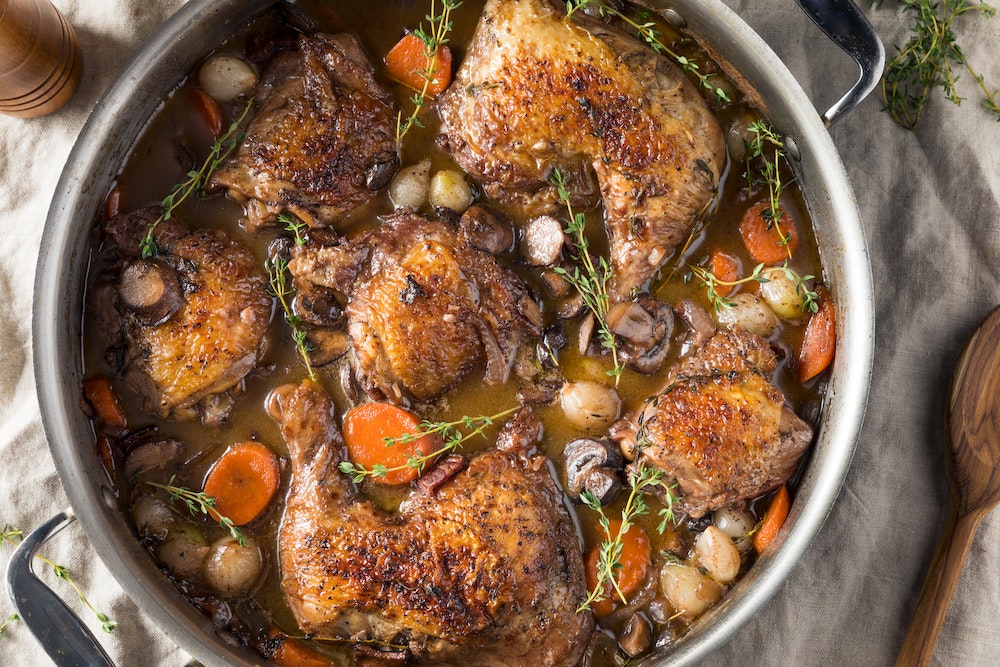When it comes to iconic French dishes, few have the universal appeal of Coq au Vin—a hearty, slow-cooked chicken dish simmered in a rich wine-heavy sauce. The dish is steeped in simplicity, relying on basic ingredients like chicken, wine, and mushrooms, yet its complexity of flavors is unrivalled.
But what truly makes a Coq au Vin stand out? Is it the quality of the chicken, the choice of wine, or the precise cooking time? In this informative article, we will unravel the secrets behind a flavorful and tender Coq au Vin with white wine, discussing ingredients, techniques, and tips to perfect this quintessential French dish.
Lire également : What’s the Best Way to Cure Homemade Gravlax with Dill and Vodka?
A Well-Prepared Chicken: The Backbone of Coq au Vin
The first and most crucial component of Coq au Vin is the chicken itself. But not just any chicken will do. The secret is in selecting the right chicken and preparing it correctly.
Historically, the term "Coq" refers to a rooster, implying a mature bird. The older birds were tougher but had a more robust flavor. To tenderize them, they were slow-cooked in wine for an extended period. While most households now use regular broiler or fryer chickens for the recipe, the key to capturing the traditional flavor is to opt for an older, free-range bird if you can find one.
En parallèle : How to Elevate a Classic Apple Crumble with Calvados and a Pecan Topping?
Before you add the chicken to the pot, it’s important to sear it in hot bacon fat. This process, called browning, imparts a deep, rich flavor and gives the chicken a beautiful golden hue. The caramelized bits left behind in the pan, known as "fond," add an extra layer of flavor to the final dish.
The Choice of Wine: Red or White?
The choice of wine can dramatically affect the flavor profile of your Coq au Vin. Traditional recipes call for Burgundy red, but using white wine results in a lighter, more delicate dish, while still maintaining a complex flavor.
When choosing a white wine, you want to go for a full-bodied variety like Chardonnay or Viognier, which can stand up to the hearty ingredients in the dish. The wine doesn’t need to be expensive, but it should be good enough to drink. After all, a large portion of the dish’s flavor comes from the wine.
As for the quantity, while it might be tempting to add an entire bottle, doing so can cause the sauce to taste too acidic or alcoholic. A good rule of thumb is to add just enough wine to cover about two-thirds of the chicken.
Building a Flavorful Sauce
Aside from the chicken and wine, the sauce is what truly defines a Coq au Vin. It’s where all the flavors meld together to create a sumptuous, mouth-watering concoction.
First, you’ll need to sauté onions and garlic in the same pan you used for browning the chicken, adding more flavor to the sauce. Then, you will deglaze the pan with a splash of cognac or brandy, which will lift the fond off the bottom of the pan.
Next, you’ll add the chicken stock and wine. The stock adds body to the sauce, while the wine provides acidity and depth of flavor. Some recipes also call for a dollop of tomato paste for a hint of sweetness and to help thicken the sauce.
Mushrooms and bacon are other crucial ingredients in the sauce. The mushrooms bring an earthy flavor, while the bacon lends a smoky, salty element. Both are sautéed separately and added to the pot towards the end of the cooking time to retain their texture.
Slow Cooking: A Matter of Time and Heat
The last secret to a tender and flavorful Coq au Vin lies in the cooking method: slow simmering over low heat. This method allows the chicken to absorb all the wonderful flavors in the pot and become ultra-tender.
Ideally, you should allow about two hours for the chicken to simmer in the sauce. This gives the flavors time to meld together and the chicken to become tender enough to fall off the bone. It’s also crucial to adjust the heat as needed to maintain a gentle simmer, as boiling can cause the chicken to become tough.
Remember, a flavorful Coq au Vin can’t be rushed. Patience is a key ingredient in this dish.
A Well-Balanced End Result
In the end, creating a flavorful and tender Coq au Vin with white wine is about balance. It’s about choosing the right chicken, selecting a robust wine, building a flavorful sauce, and taking the time to slow-cook the dish to perfection. Remember, it’s not just about following a recipe—it’s about understanding the role each ingredient plays and how they all come together to create a symphony of flavors.
Once you’ve mastered these elements, you’ll find that the humble Coq au Vin is more than just a chicken dish—it’s a culinary masterpiece worthy of any fine dining establishment.
The Essential Addition: Pearl Onions, Tomato Paste, and More
Indeed, the secret to a sublime Coq au Vin goes beyond just the chicken and the wine. It’s the smaller, often overlooked ingredients that turn this simple dish into something extraordinary.
For instance, pearl onions are an essential addition to any Coq au Vin recipe. These small, sweet onions lend a subtly sweet note to the rich sauce, balancing out the wine’s acidity. They should be browned first and then added back into the pot during the last 30 minutes of cooking to ensure they maintain a slight crunch.
Equally important is the use of tomato paste. Even though it’s a small amount, the tomato paste adds a tangy sweetness that enhances the depth of flavor in the dish. It’s added after the onions and garlic have been sautéed and is cooked for a couple of minutes until it darkens in color, a process known as ‘blooming’, which intensifies its flavor.
Other ingredients like carrots and bay leaves can also be added to provide a hint of sweetness and a layer of fragrant complexity respectively. Carrots are sautéed with the onions and garlic, while bay leaves are added to the pot along with the chicken stock and wine.
The chicken pieces, whether they be thighs, breasts, or a whole chicken cut into parts, are then returned to the pot. They’re nestled into the sauce and cooked until they’re so tender that they practically fall off the bone.
It’s also worth noting that a good Coq au Vin should never be too salty or overly spiced. In the end, the flavors of the chicken, wine, onions, and other ingredients should harmonize, not compete. Thus, salt and pepper should be added sparingly, and a classic French bouquet garni (a bundle of herbs) can be used for a subtle hint of herbiness.
Serving Suggestions: Mashed Potatoes and More
While Coq au Vin is undeniably the star of the show, what you serve it with can elevate your dining experience. A classic choice is mashed potatoes. Their creamy, buttery texture makes them the perfect vessel for soaking up the rich wine sauce.
Another traditional accompaniment is a simple baguette. The crusty bread can be used to mop up any remaining sauce, ensuring that not a single drop is wasted.
For wine, if you’ve used a white wine in your Coq au Vin, a bottle of the same variety served chilled would make a suitable pairing. For example, if you used a Chardonnay for cooking, serve a chilled glass of Chardonnay alongside the meal.
And finally, don’t forget the garnish. A sprinkle of fresh parsley or thyme not only adds a pop of color but also a fresh, herby note that cuts through the richness of the dish.
Conclusion: The Art of Coq au Vin
In conclusion, a truly flavorful and tender Coq au Vin with white wine is not just about following a recipe – it’s an art. It’s about understanding how to maximize the flavors of simple ingredients like chicken, wine, and mushrooms, and how to balance them in perfect harmony.
From selecting the right chicken to browning it in bacon fat, from the crucial choice of wine to the slow simmering process, every step matters. But remember, this isn’t a dish to be rushed. Allow yourself the time to enjoy the process, and the result will be a Coq au Vin that is not just a meal, but an experience.
Now that you know the secrets, why not try your hand at making this classic French dish? Whether you stick with tradition and use a robust red like Pinot Noir, or opt for a lighter, more delicate white wine, a well-made Coq au Vin is sure to impress. Bon appétit!






